From the Pop Economy to Foreign Policy
As 2023 draws to a close, Ipsos looks back on another year of living in “interesting times.” Despite the countless individual events that shaped the year, Ipsos identified five big picture trends that truly changed the country.
- Economic turmoil points in different directions
- Pop culture-fueled economy
- Americans live through the hottest summer on record
- Former president and current frontrunner for major party faces multiple indictments
- Foreign policy reclaims a place on the agenda
What did Americans expect coming into 2023?
Many Americans at the end of 2022 thought that 2023 would bring a recession, worsening inflation, and unprecedented extreme weather events. Some even thought the U.S. would be visited by aliens and a rogue artificial intelligence system would cause significant havoc for the country in 2023.
Americans got some of their predictions right, and others wrong. There was no recession, inflation eased, extreme weather was extreme, aliens did get airtime in Congress, but AI fears have not come to fruition though they are still present among the public.
Many other historic events shaped the past year, including wars in the Middle East and Europe, and former President Donald Trump, the frontrunner for the Republican presidential primary, being charged with multiple criminal indictments. Americans, and the world at large, are living through the age of polycrisis, where there are interlocking and competing wide-scale crises. The past year has underscored that trend.
Even as the world and country changed, political division continues to frame the seismic shifts the public experienced. Below, Ipsos unpacks the biggest stories of the year, examines how the public reacted and looks ahead to see where the country may be headed.
The economy: A historic year for labor. Inflation eases even as its mark remains. Consumer debt is a worry for 2024.
More workers went on strike this year alone than they have in the past generation. Following the Great Recession in 2008, labor unrest remained subdued. This year, with a tight labor market, the persistently high cost of living and fears about artificial intelligence, strikes were widespread, from autoworkers to actors and writers.
As workers made their voices heard, the higher cost of living remained a worry for many Americans. What did Americans do to compensate for higher prices this year? They dipped into their savings and leaned on credit card balances. Average monthly credit card balances reached $1 trillion, with balances increasing since inflation started to pick up last year. Fewer have the cushion they had before the pandemic, and more have credit card balances. This is a precarious place for consumers and the economy they drive.
Consumer confidence throughout this all remained remarkably lukewarm, with expectations high. But lingering malaise and consumer hesitation around things like major purchases demonstrates how caught in the middle people are between the many economic forces at play.
In 2024, pay attention to how inflation changes and whether there is any shift in credit card balances and savings.
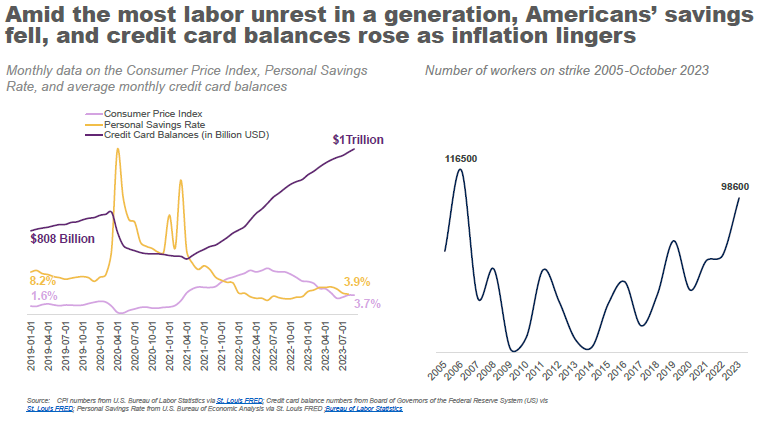
Escapism, pop stars and Barbie pink fuel the American economy. Will it last?
After a tumultuous few years, Americans spent on escapism in 2023. From the summer of Taylor Swift and Beyonce concerts to the record-breaking “Barbie” movie, anywhere but here at any cost was for where Americans were putting their money.
In fact, many economists attribute third quarter 2023 GDP growth to robust consumer spending spurned on by blockbuster events like Taylor Swift’s Eras tour, Beyonce’s Renaissance tour, and big movie moments like “Barbie” and “Oppenheimer.” American consumers remained resilient with no recession sinking in. Still, other indicators, like falling savings and growing debt, seem to indicate that spending may cool, slowing economic growth. Consumers have been incredibly hard to predict in the post-pandemic economy. How inflationary pressures, fiscal policy, and the latest pop culture moment add up and influence American consumer behavior will be a space to watch in the new year.
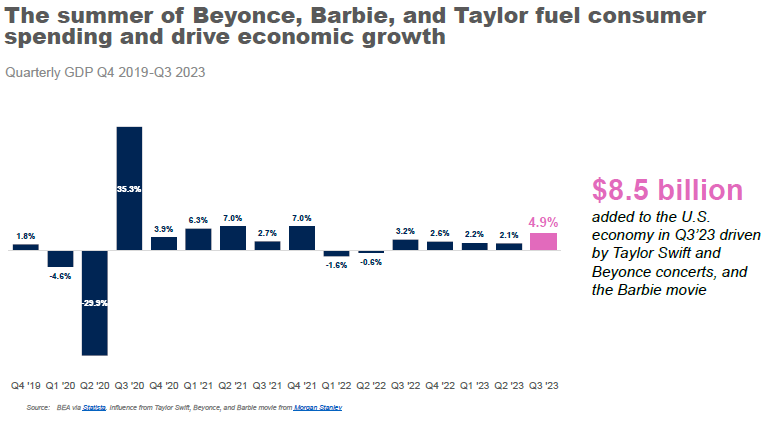
Americans lived through the hottest summer on record. Political divisions color what they experienced.
For millions of Americans, the past 12 months offered a visceral and intimate encounter with extreme weather. From unnamed storm systems turning into violent hurricanes in a matter of hours to the red-orange sky from the Canadian wildfires that cloaked and choked much of the U.S. to the suffocating heat and humidity in the South, the climate future many feared was down the road is now a reality.
In July 2023, half of Americans reported encountering extreme weather, USA Today/Ipsos polling found. Extreme heat, poor air quality, severe thunderstorms, and heavy rainfall were the most commonly reported extreme weather events that Americans lived through.
This was the hottest summer on record and on pace to be the hottest year on record. Most of the country experienced some form of extreme and unusual weather this summer. However, America’s political divide colors people’s reality, with more Democrats than Republicans or independents reporting that they experienced these intense weather events. Looking ahead, expect the intractable state of American politics to continue to shape how the public responds to an increasingly erratic and harsh weather.
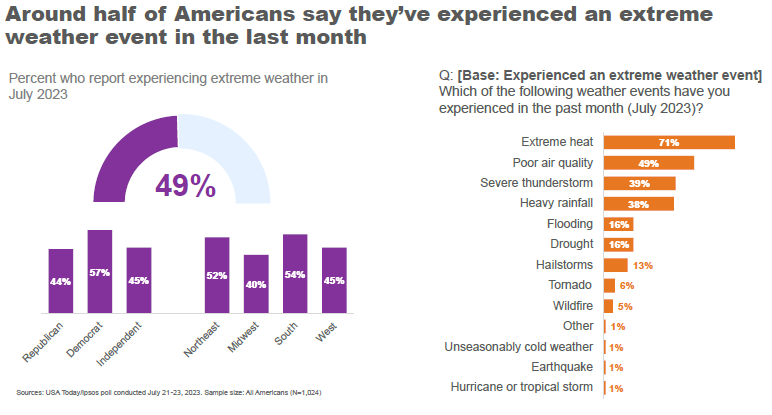
Americans are divided over former President Trump’s indictments – expect that to continue.
After nearly 250 years without a sitting or former president being brought up on criminal charges, former President Donald Trump shattered that record with his four criminal indictments this year. Not only was this history-making because of Trump’s status as a former president, but it is also notable because he is the current frontrunner to represent Republicans in the 2024 race for the White House.
Still, despite these massive upheavals to political norms and systems that these indictments represented, public opinion remained remarkably consistent and divided. Republicans largely don’t view the indictments as serious and don’t think Trump should be charged, questioning the political motivations and charges against him. Democrats almost unanimously feel Trump should be charged and believe the cases against him are serious, while independents are more mixed.
The new year will bring more historic events, with Trump set to stand trial during a run for the presidency. The way these cases play out in the media, courtrooms, and among the public will be important context as the 2024 presidential election takes shape.
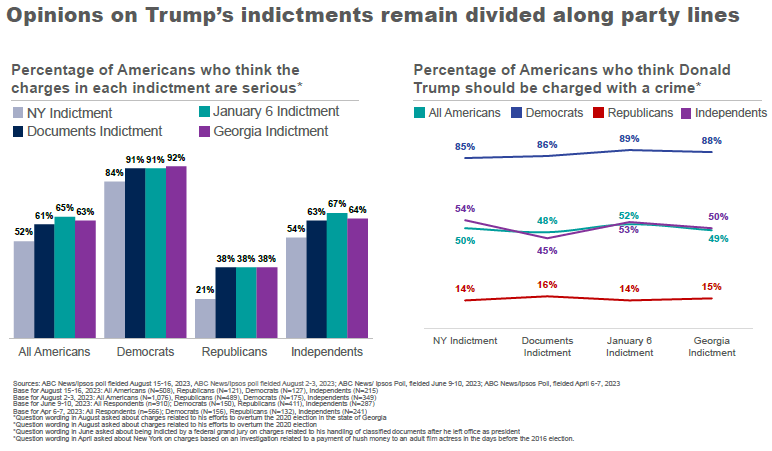
Ukraine and Israel at war, dividing Americans along partisan lines, posing questions for U.S. foreign and domestic policy in 2024.
Two U.S. allies – Ukraine and Israel – are now engaged in bitter wars, bringing increased geopolitical uncertainty and threatening to start broader conflicts.
The politics surrounding these two conflicts and the public’s support for U.S. policy are mediated by people’s politics. Republicans are more likely to feel that the U.S. is doing too much to support Ukraine in its war with Russia, while far more Republicans feel that the U.S. is doing too little to support Israel in its war with Hamas. Majorities of Democrats feel the U.S. is doing the right amount in both supporting Ukraine and
The domestic consequences of these at-odd politics are real. Congress has threatened to shut down the government numerous times in 2023 over fights about aid to Ukraine. In the new year, look at how American public opinion continues to take shape and split on these two conflicts and how that frames America's role on the international stage.
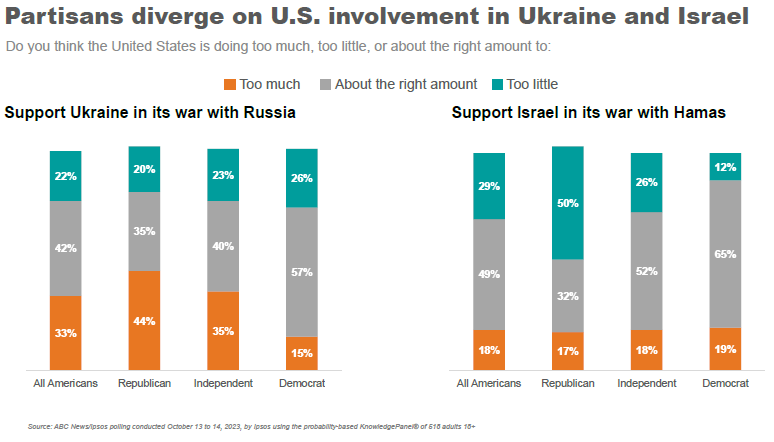
With all that’s happened, here are five things to watch in 2024:
- Whether the economy remains resilient in the face of geopolitical uncertainty
- Extreme weather and the new climate reality Americans are coming to terms with and living through
- Former President Trump’s trials and charges, and how they play out in the 2024 presidential race
- Whether America’s polarized public and Congress will pursue internationalism or isolationism
- How America’s relationship with AI develops and whether the regulatory environment changes the public’s interactions with the technology

![[WEBINAR] Understanding GEO: How to Get Recommended and Reach Shoppers on AI](/sites/default/files/styles/list_item_image/public/ct/event/2025-11/thumbnail-templates.png?itok=KvQQfkES)

